SanDisk Extreme 900 USB 3.1 Gen 2 Portable SSD Review
by Ganesh T S on April 11, 2016 8:00 AM ESTSynthetic Benchmarks - ATTO and CrystalDiskMark
SanDisk claims read and write speeds of 850MBps using ASMedia's USB 3.1 Gen 2 host controller. Our results with the Intel Alpine Ridge controller, didn't match up on the write side, but ATTO's read numbers definitely measured up. Unfortunately, these access traces are not very common in real-life scenarios.
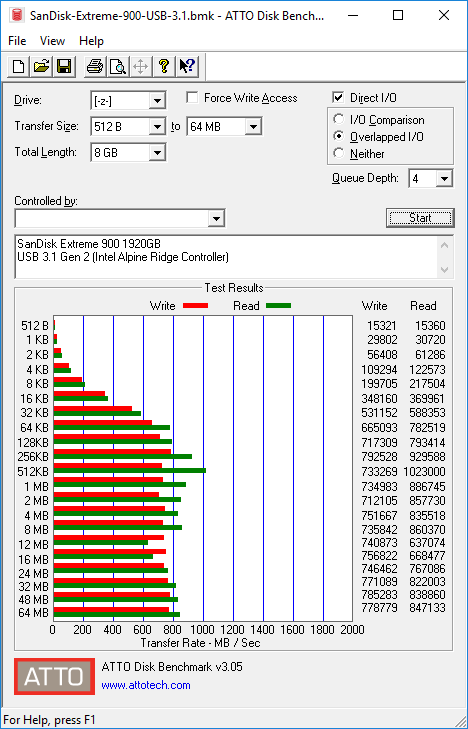
CrystalDiskMark, despite being a canned benchmark, provides a better estimate of the performance range with a selected set of numbers. As evident from the screenshot below, the performance can dip to as low as 26 MBps for random 4K accesses with low queue depths.
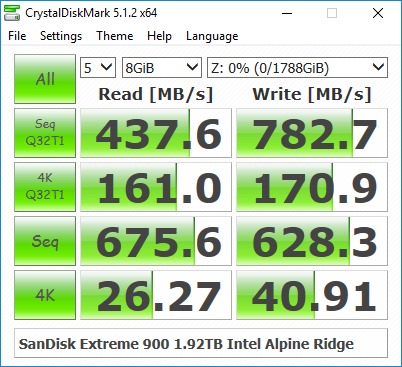
Benchmarks - robocopy and PCMark 8 Storage Bench
Our testing methodology for DAS units also takes into consideration the usual use-case for such devices. The most common usage scenario is transfer of large amounts of photos and videos to and from the unit. The minor usage scenario is importing files directly off the DAS into a multimedia editing program such as Adobe Photoshop.
In order to tackle the first use-case, we created three test folders with the following characteristics:
- Photos: 15.6 GB collection of 4320 photos (RAW as well as JPEGs) in 61 sub-folders
- Videos: 16.1 GB collection of 244 videos (MP4 as well as MOVs) in 6 sub-folders
- BR: 10.7 GB Blu-ray folder structure of the IDT Benchmark Blu-ray (the same that we use in our robocopy tests for NAS systems)





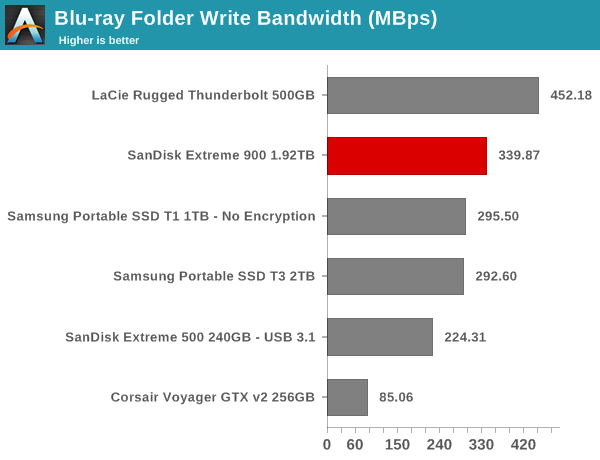
For the second use-case, we take advantage of PC Mark 8's storage bench. The storage workload involves games as well as multimedia editing applications. The command line version allows us to cherry-pick storage traces to run on a target drive. We chose the following traces.
- Adobe Photoshop (Light)
- Adobe Photoshop (Heavy)
- Adobe After Effects
- Adobe Illustrator
Usually, PC Mark 8 reports time to complete the trace, but the detailed log report has the read and write bandwidth figures which we present in our performance graphs. Note that the bandwidth number reported in the results don't involve idle time compression. Results might appear low, but that is part of the workload characteristic. Note that the same testbed is being used for all DAS units. Therefore, comparing the numbers for each trace should be possible across different DAS units.


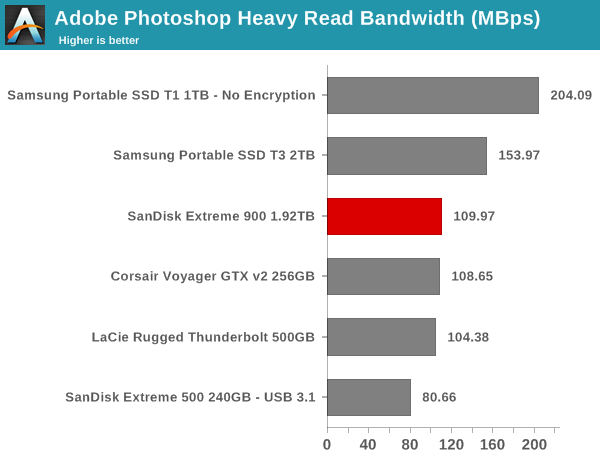

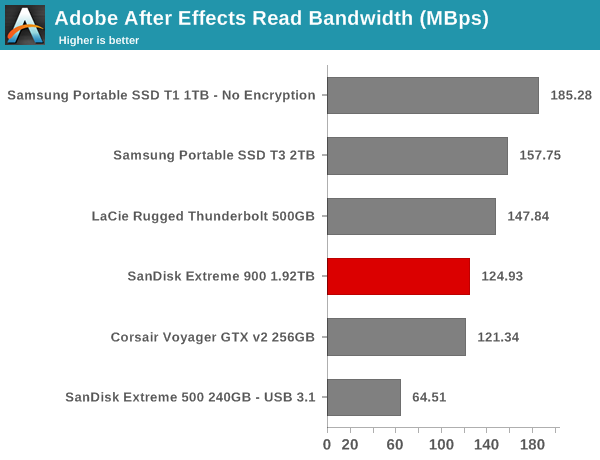
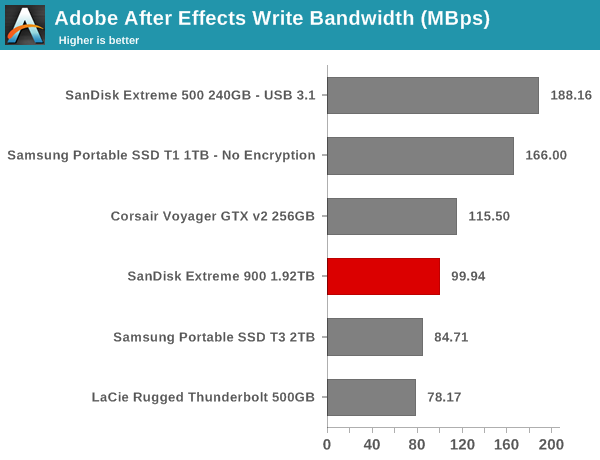
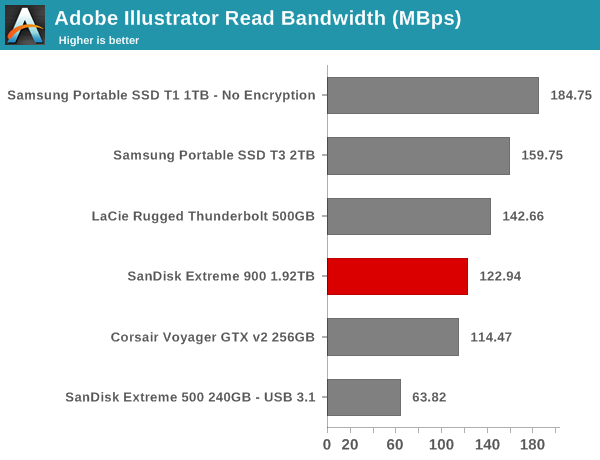

Certain access traces work heavily in favor of RAID 0 SSDs, but others end up with a run-of-the-mill performance. However, it can be said that the Extreme 900 works better than a USB 3.0 flash drive (SSD-based or otherwise) for most practical access traces.










31 Comments
View All Comments
Holliday75 - Monday, April 11, 2016 - link
Do those $10 enclosures support RAID 0? I'm sure there are some on the market, but to support RAID 0, USB 3.1 gen2? Doubt there are many if any on the market.littlebitstrouds - Monday, April 11, 2016 - link
I've got this 2 bay 3.1 gen2 from Startech. Have two 480gb Sandisk Ultra II SSD's running RAID 0. I get 420 MB/s read and write with my Macbook Retina. I'm on the road, so I haven't tried them on my desktop, with true 3.1 gen2 support yet.http://www.amazon.com/StarTech-com-10Gbps-External...
ganeshts - Monday, April 11, 2016 - link
Nice one.. it is not $10, but $95, but a good solution for sure.Unfortunately, it is not bus-powered or as compact as the Extreme 900. That said, it is definitely more flexible with the configurable RAID levels.
jameskatt - Saturday, May 7, 2016 - link
I'd rather have a boring enclosure design that is as small and utilitarian as possible. No need for extra fins and doodads. Just do its job and stay out of the way.digiguy - Monday, April 11, 2016 - link
I wonder if we'll see at some point external enclosures capable of supporting PCIe SSDs that can saturate 10Gb/s and/or even use Thunderbolt 3 to transfer data up to 40Gb/sname99 - Monday, April 11, 2016 - link
"with a peak power consumption of around 8.1W. SanDisk suggests using USB ports capable of delivering up to 10W of power for optimal performance. It is obvious that using a port capable of delivering only the usual 5W will heavily hamper the performance of the unit."
I'm sorry but this is an unacceptable ending to a pretty good review.
There is no such thing as a "usual 5W USB port". A USB2 port will give you 2.5W, a USB3 port will give you 4.5W. Hoping that you'll be lucky and get more is a recipe for tears.
Next, since SANDisk provide an A-connector, what actually HAPPENS when you use a 2.5 or 4.5W port? I'm somewhat dubious of the claim that it will just "heavily hamper the performance". At the very least I'd like to see some testing of this, with verification that the device does not simply randomly disconnect when it wants to power-draw beyond the allowed limit. Even assuming it is well-enough engineered to run properly on these lower power-draws, how much of a performance hit are we talking?
This is part of a larger problem that, especially in the context of external drives (and, to some extent, WiFi equipment) AnandTech lives in blissful ignorance of the real world. Sure your labs don't contain a single devices manufactured before January 2016, but in the real world, a substantial use case for external USB drives involves their being swapped between different machines. THIS is why it REALLY matters to know how well they can handle being connected to older ports.
This is not just some weird corner case, like a person complaining "well you didn't test that new SATA SSD drive when you connect it to 2007 SATA-66 box, and I really care about that situation"; it gets to the actual fitness of purpose for I would guess many, if not a majority, of the use cases of this sort of external USB drive.
ganeshts - Monday, April 11, 2016 - link
No disconnects. Checked with a traditional USB 3.0 port. Some sort of throttling going on, which reduces the speed.DanNeely - Tuesday, April 12, 2016 - link
All hyperbole from name99 aside; some degree of benchmarking at lower power levels needs to be done for all high power usb flash devices for the next few years. Not necessarily the full suite; but one or two tests suitable to characterize what the fallback performance levels will be for people not having the latest and greatest hardware to plug them into.epobirs - Monday, April 11, 2016 - link
Which is why the SIIG USB 3.1 Gen 2 single bay enclosure comes with a dual host port cable, Type A on both ends.I have a 480 GB Patriot Blast SSD in it and it does a pretty nice job of saturating the SATA bus. Things should get more interesting if and when somebody produces an SSD controller that avoids the SATA bottleneck and taps into USB 3.1 fully.
TheUsual - Monday, April 11, 2016 - link
No 'The'? I don't think every device deserves a 'The' at the beginning of the review, just the very important, well known devices.